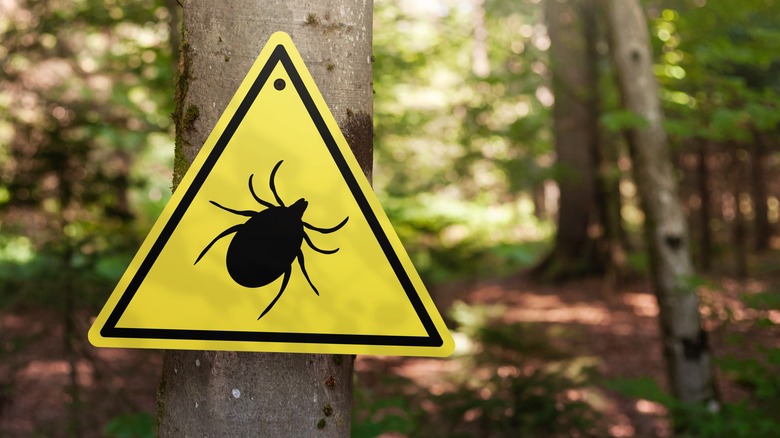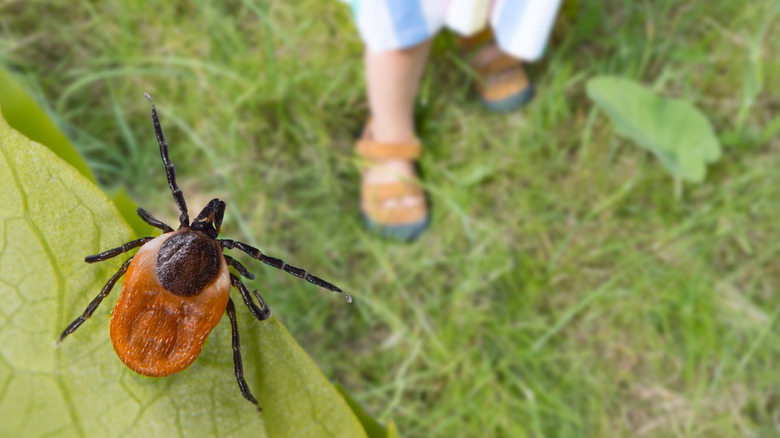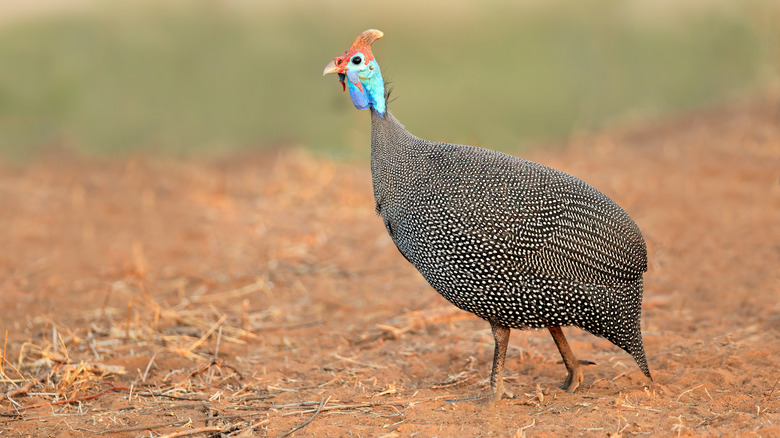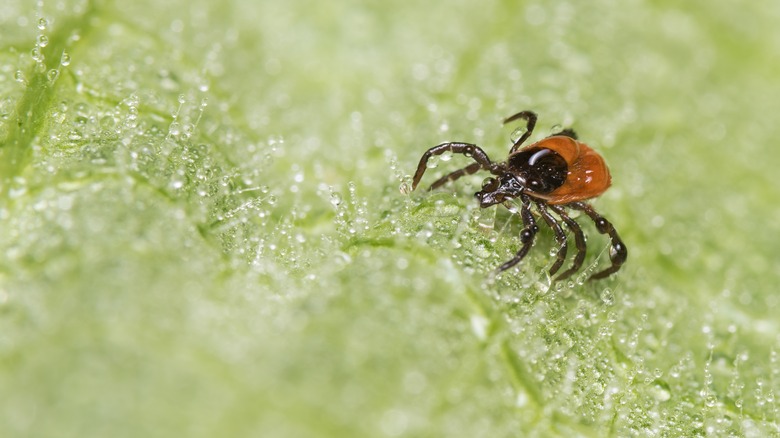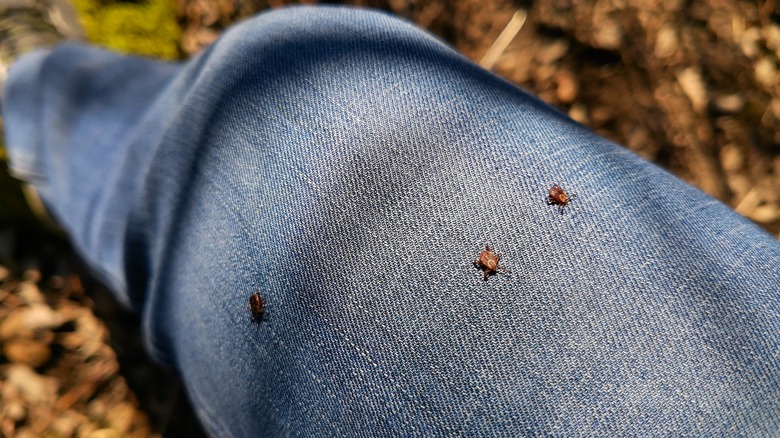What Would Happen If Ticks Disappeared From The Planet?
If you've ever pulled a tick off you after a long day of exploring the great outdoors, you've probably yelled the question (along with some expletives), "What are you even good for!?" That, or you've dreamt of a world where all the ticks, and other nasty little things like them, disappeared forever. Even better, an alternate dimension where they never existed. There are many kinds of ticks out there — blacklegged ticks, lone star ticks, American dog ticks (via LymeDisease.org), along with 900 other species (via Igenex).
With that number — and the knowledge that in some states, like Connecticut, there are areas with over 20,000 ticks within a square mile — it's easy to feel outnumbered by these little blood-sucking fiends (via Connecticut Health I-Team). Even scarier, ticks can carry several diseases, like the most commonly known Lyme disease, Powassan disease, and anaplasmosis, just to name a few (via Centers for Disease Control and Prevention). Let's just say we apologize in advance for making your skin crawl with this article.
Tick-Transmitted Diseases
While there are a plethora of diseases carried by ticks, we're going to dive further into one of the ones we mentioned here (via Centers for Disease Control and Prevention). When most people see a tick on them, they immediately panic about contracting Lyme disease. It's carried by blacklegged ticks and western blacklegged ticks throughout much of the United States and commonly causes fatigue, erythema migrans (otherwise known as the despicable bullseye), headache, and high fever (via Centers for Disease Control and Prevention). It's usually not too serious if caught in time through lab testing and treated with heavy antibiotics. Without medical attention, it can cause lasting infection in the nervous system, heart, and joints.
And if you're the kind of person to cry more when dogs die in movies than when people do — you're going to hate this next part. There's a serious tick-born neurotoxin that causes paralysis in dogs, produced by certain species, like the American dog tick and Rocky Mountain wood tick (via Columbia University Irving Medical Center). Known as "tick paralysis," it usually has a gestation period of up to nine days, but once it hits, it hits hard for the next day or two (via PetMD). Paralysis usually starts in the legs and then can affect breathing and facial nerves. Usually, it can be treated, but it's a bit difficult to pin down what's going on during the chaos. Even considering this, believe it or not, ticks actually do some good for animal life.
Population Control
Although most tick-borne illnesses are manageable when treated in time, there are still countless pets — and even people — who are affected or even killed by them. While we may not want anyone under our own roof to be bitten by ticks, they do aid in population control for wildlife (via The New York Times).
In the same way that they take life away, they also give life by promoting biodiversity. Ticks, when biting a host, can transmit a microorganism called spirochetes, which they often host themselves. When spirochetes reach their secondary host, like white-tailed deer, they wreak havoc on their system, weeding out the weakest link in populations. Ticks also carry other forms of bacteria and microorganisms (via TickSafety.com). While being the harbingers of disease doesn't sound great, ticks actually act as food for some animals, further supporting biodiversity and the circle of life.
Sometimes you eat, sometimes you get eaten
Ticks serve as nutrition for countless small animals, including birds, livestock, reptiles, and even the rodents that frequently carry them (via TickSafety.com). Wild bird species like guinea fowl and turkeys, as well as other small critters like opossums, are particularly fond of them. Some farmers will even buy guinea fowl or chickens to keep on their properties to protect themselves and their livestock from ticks and the diseases they carry (via The University of Maine).
Sadly, this method sometimes backfires. While the birds roam the farm in search of grub, they can become hosts themselves, carrying the pests about the farm to different hosts. Other natural tick-prevention tactics that have been tested are the employment of tiny parasitic wasps in an environment — which are a natural-born predator to the ticks — as well as a type of roundworm. There have also been studies with pathogenic fungi, which enter the system of the tick and (to keep scientific terms at bay for us laypeople) basically make them implode from the inside out. While we might not want to talk about complicated scientific processes, ticks can actually be a scientist's best friend.
Ticks: The Best Lab Assistants
Considering ticks feast on blood, it only makes sense that the tiny pests can tell scientists how an ecosystem is doing from a biological standpoint (via TickSafety.com). Depending on how many ticks there are in a given area, scientists can also tell how biodiverse the ecosystem is and how dense populations of certain wildlife are — helping with study and conservation efforts. So while ticks help control populations and kill off weaker wildlife, they also preserve life.
For instance, if there are plenty of ticks in an ecosystem, this tells scientists that small critters — like rodents and rabbits — are thriving. This is because the ticks not only feed on the smaller animals, but the smaller animals also, in turn, feed on them. Alternatively, the decreased presence of ticks in an area can be alarming, as it could indicate those on top of the food chain are prevailing or even outnumbering the prey they feed on.
There are still too many though
A world without ticks or other pests just could not be — as much as we would want it to — because all the "good" they do is a vital component in the circle of life. Regardless of this, there are still way too many of them. Thanks to climate change and milder winters, ticks have been increasing in numbers, making themselves known for much longer into the year than in the past (via The National Wildlife Federation). Ticks cannot survive the cold, but with the population boom they've seen in warmer temperatures — we need to be warier of tick-borne illnesses.
The most effective ways to dissuade these arachnids (yes, they're like spiders, if they weren't creepy enough) from biting you are staying on the trail and out of tall grass, wearing long pants and sleeves, using DEET-containing repellant, and checking for ticks when you get home, as well as showering. If you're worried about ticks on your clothes, wash them, or put them in the dryer on high heat to fry those little buggers off.
